from BBC News - Health https://ift.tt/2CTSHHf
via IFTTT
July is a time for sunshine, swimsuits and serious sweat sessions. It’s also a time to make sure we all stay cool, covered and safe. That’s why MISSION Instant Cooling Gear and their proathlete founders are dedicated to spreading the importance of National Heat Safety Month this July.
Co-founder Chris Valletta, former NFL player, experienced heat related illness during his college and professional football playing days — so this initiative is personal for him.
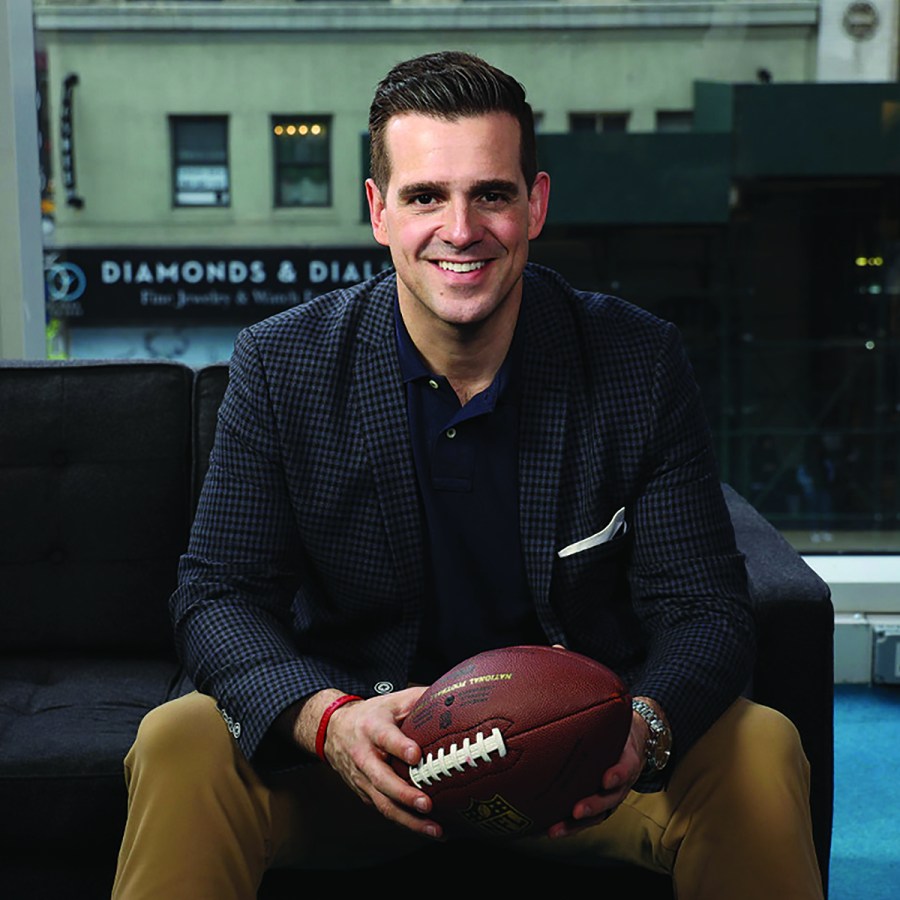
Mission is so passionate about Heat Safety they invested in The Mission Heat Safety Lab at UConn’s Korey Stringer Institute. Mission products have been tested on athletes with state-of-the-art equipment like high speed treadmills, advanced bike ergometers and a comprehensive physiological monitoring system — so you know these items are legit!
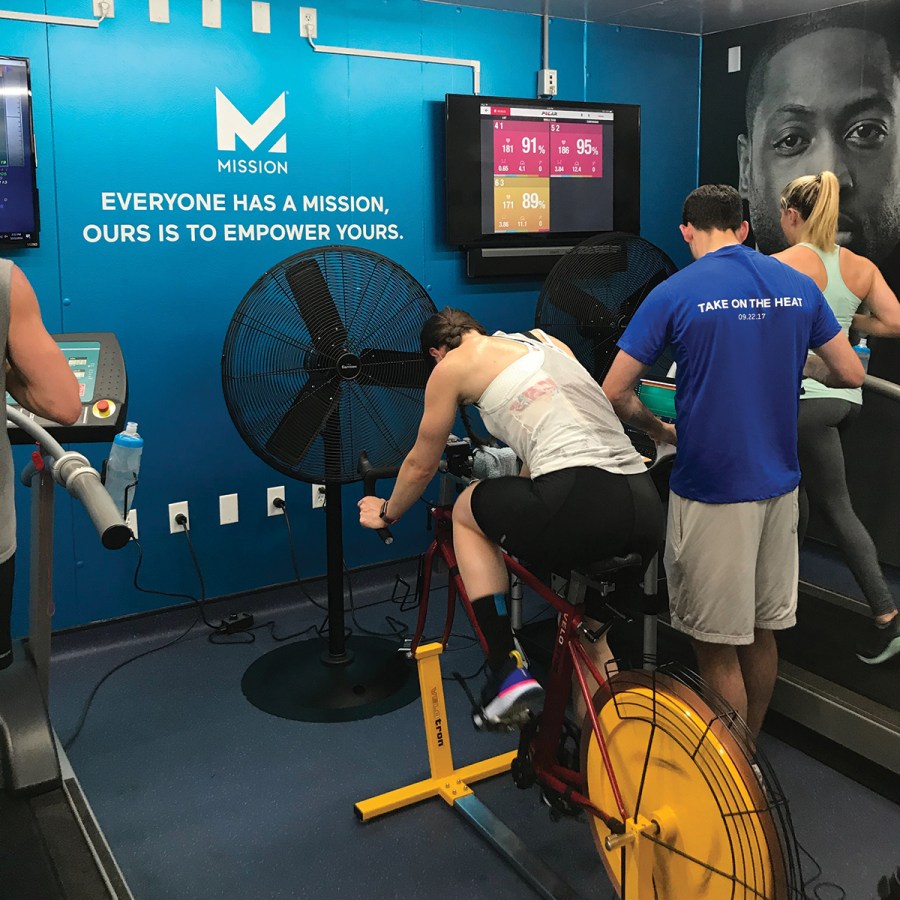
“Mission and the Heat Safety Coalition has the ultimate goal of improving heat safety in the consumer and industrial settings. These cooling products are a vehicle to get there.” —Dr. Casa, CEO, Korey Stringer Institute, Professor, Department of Kinesiology, Director, Athletic Training Education.
Here are some tips to stay fit, cool and most importantly safe this summer with Mission Cooling Gear.
Don’t forget to wear a MISSION Cooling Performance Hat to block the sun and try to avoid running outside between 10 AM and 4 PM when the sun is strongest.
Look for a shaded area where you can all get a little family fitness in! Make sure to arm the entire family with MISSION Cooling Towels. Their brushed microfiber cools instantly.
Even moderate workouts like taking your furry BFF Gaiter to stay safe for a stroll are more intense during the summer months. Rock this MISSION Gaiter to stay safe and cool. And don’t forget water for you and your pet.
Mission Cooling Gear available at Walmart, The Home Depot, Target, CVS and Mission.com
Everyone has their spirit of choice, but not many can say that theirs comes with added health benefits. If tequila isn’t your favorite spirit, you may want to rethink your go-to drink.
100% agave tequila is one of the cleanest liquors out there and, when consumed in moderation, can actually improve your overall health. So, drink up (responsibly, that is) and enjoy in more ways than one.
For the calorie conscious, tequila is the way to go with around 60 kcal per shot — much lower than wine, champagne and hard seltzers. 100% agave tequila is also gluten free and even helps aid in digestion by promoting growth of good bacteria.
Contrary to other spirits, tequila is an upper rather than a downer, so it’s more likely to elevate your mood. It also contains less congeners (fermented products found in most spirits), which is much less likely to give you a hangover the next day.
Relaxation and calming are also some of the positive effects of tequila. A small amount before bedtime can reportedly help you fall asleep faster and sleep more soundly.
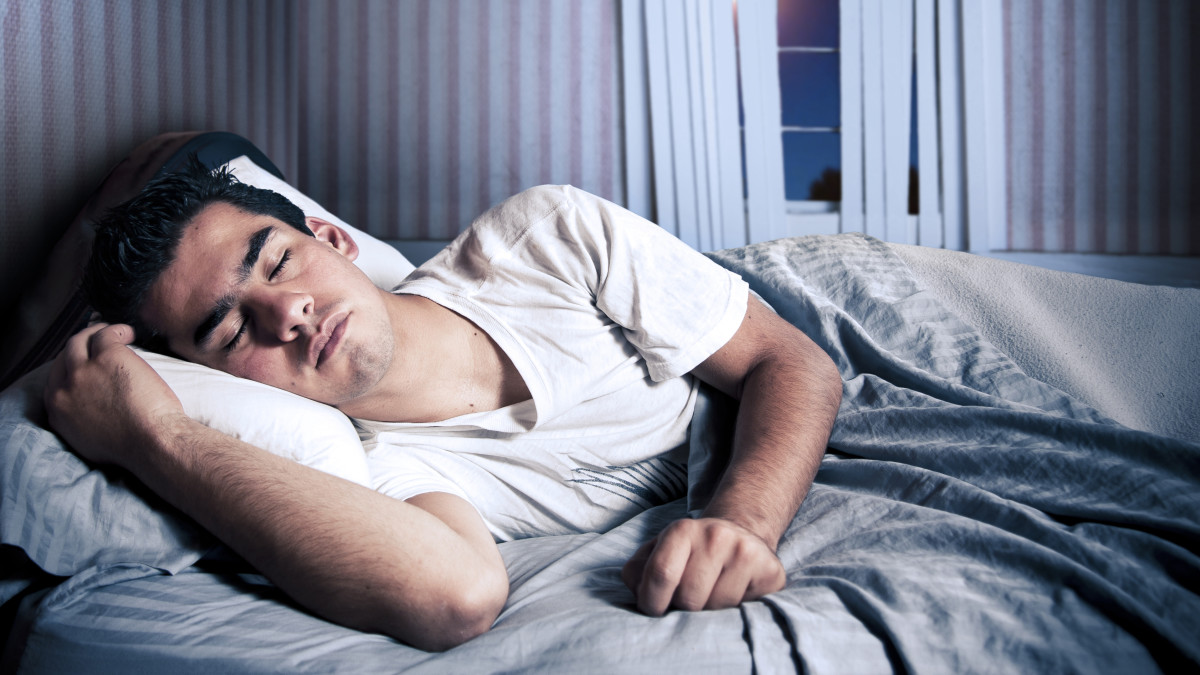
Ready to turn up and reap some bonus health benefits? 100 Coconuts has infused 100% agave tequila into their delicious 100% Pure Coconut Water for the best results you could ask for in a cocktail. Enjoyed in moderation, you can sip your way to good health all summer long! www.100coconuts.com
During this pandemic-prolonged absence of competitive sports, we can at least count on C-SPAN for a daily dose of distraction and entertainment. The cutthroat arena of political MMA that can only be viewed in the U.S. Senate recently produced a real-world underdog tale for the ages with longstanding implications for outdoor aficionados of all walks.
Earlier this month, the notoriously gridlocked chamber took a major step toward attaining what many consider the Holy Grail of conservation legislation in the modern era. Known as the Great American Outdoors Act, the landmark legislative package—one that provides unprecedented benefits to the nation’s system of public lands—passed through the Senate with a rare showing of bipartisan support. The anticipated slam dunk victory now moves to the U.S. House of Representatives and eventually the Oval Office for the president’s signature.
Should the bill emerge triumphant, it’s the American public that will ultimately reap the spoils. Everyone from hikers to hunters, bikers to boaters, plus millions more who enjoy access to America’s 640 million acres of national public lands for countless other outdoor activities, will be rewarded with increased opportunities and improved infrastructure as they pursue their passions. And in states like Colorado, where the culture is largely rooted in public lands recreation, the ripple effect is expected to make an even bigger impact.
“Colorado’s public lands drive our businesses—from breweries and restaurants, to bike shops and fly-fishing guides—and inspire our adventures with family and friends,” said Steve Fechheimer, CEO of New Belgium Brewing in Fort Collins, CO. “The passage of GAOA is an incredible milestone in ensuring protections for our environment, our economy and our well-being.”
More than 20 years in the making, the Great American Outdoors Act (S.3422 ) ultimately combines two pieces of public lands legislation. The first piece, dubbed the Restore our Parks Act, establishes a five-year trust generated by revenues from energy development that provides up to $1.9 billion a year to begin addressing the more than $22 billion worth of maintenance backlogs at national parks and other public lands across the country. That includes everything from road and trail maintenance to facility improvements and even wildlife habitat.
The second piece fully and permanently funds the Land and Water Conservation Fund (LWCF) used to buy and improve public land. The fund, which is supposed to receive $900 million a year from offshore drilling royalties, is regularly raided by legislators and has only been fully funded twice since it was established in 1964.
Throughout its history, LWCF funds have been used to acquire and improve public lands in every county of every state, everything from New York’s Central Park to Yellowstone National Park.
Once the bill is signed into law by the president, full funding begins in fiscal year 2021. The LWCF has used money from offshore oil and gas drilling royalties to conserve our public lands and waters across the country for more than 50 years already, and legislation passed in 2019 guaranteed that $900 million will be collected for the fund every year. The GAOA ensures that the money will go to its intended purpose.
The GAOA also establishes the National Parks and Public Land Legacy Restoration Fund, providing federal land management agencies with critical resources to address the deferred maintenance backlog on our public lands. The fund receives 50 percent of unallocated revenues generated from energy development on federal lands and waters, providing up to $9.5 billion over five years beginning in FY2021 through FY2025.
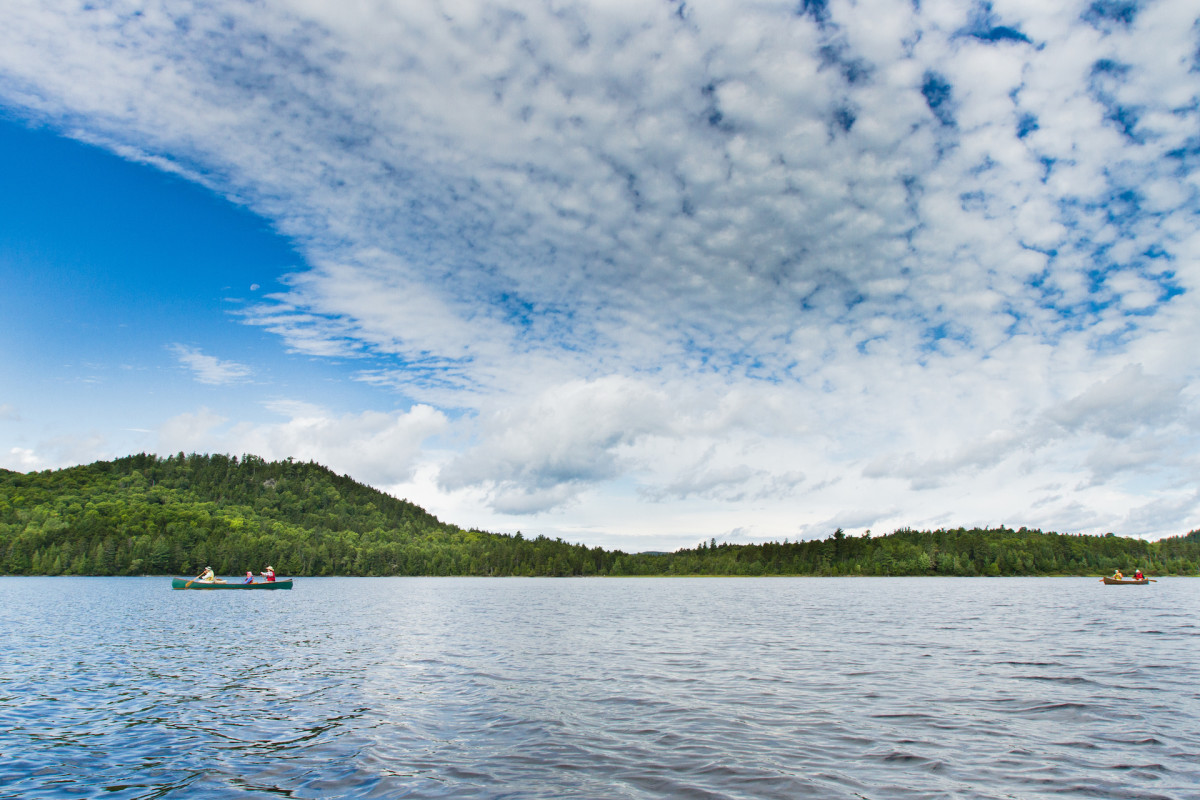
From rock climbers in Colorado’s Black Canyon of the Gunnison National Park to paddlers on the Allagash Wilderness Waterway in Maine, just about anyone who enjoys outdoor recreation has seen benefits from the LWCF, and those benefits will increase with the implementation of the GAOA.
Notably, the National Parks and Public Land Legacy Restoration Fund portion of the act promises funding for federal land management agencies above and beyond the National Parks Service. While the NPS will receive 70 percent of the funding ($1.3 billion a year), the remainder will be split between the U.S. Forest Service ($285 million), U.S. Fish and Wildlife Service ($95 million), Bureau of Land Management ($95 million) and Bureau of Indian Education ($95 million) to fund habitat improvement projects and other maintenance backlogs in those agencies.
“The National Parks Service maintenance backlog is the biggest part of it, but the rest of it is substantial too,” said Corey Fisher of Trout Unlimited’s Sportsmen’s Conservation Project. “The places that are most important to hunters and anglers are managed by the Forest Service and the Fish and Wildlife Service, not the National Parks. So it was super important to groups like TU to have those included.”
Additionally, the LWCF provides matching grants to states and local governments to acquire and develop public outdoor recreation areas and facilities that provide close-to-home recreation opportunities that are readily accessible to youth, adults, senior citizens and the physically or mentally challenged in urban and rural communities.
The Land and Water Conservation Fund has long been recognized as the most powerful program we have for conserving habitat and opening access to the nation’s most precious natural resources, and its guaranteed funding couldn’t come at a more critical time. President Trump had nearly zeroed out the money for the LWCF in budgets he’d submitted to congress in recent years, only recently coming around in favor of the program that Senate bill sponsor Cory Gardner (R-Colo.) claims supports between 16-30 jobs for every million spent in LWCF funds. Fixing the national parks promises to create as many as 100,000 additional jobs, making the Great American Outdoors Act an essential economic recovery tool that also enhances our public lands and outdoor recreation opportunities.
“The Great American Outdoors Act is an enormous victory for public lands and for rural economies here in the Mountain West,” said Teresa Martinez, Executive Director of the Continental Divide Trail Coalition. “It will address vital needs on our trails and forests. It will create jobs. And by fully funding the Land and Water Conservation Fund, it will be absolutely critical to our efforts to complete the Continental Divide Trail.”
The Great American Outdoors Act offers a sustainable funding solution that expands and protects valuable public lands from the impacts of overuse destined to exacerbation over time. While their popularity continues to grow, America’s national parks and public lands have been underfunded and understaffed for decades. And as urban populations swell, local outdoor recreation opportunities remain in decline, increasing barriers of entry to fundamental activities like hiking, biking and fishing that have emerged as critical ingredients in the recipe for both mental and physical health.
“With the pandemic shining a bright light on the need for equitable access to natural spaces, securing LWCF permanent funding and tackling a substantial portion of the public lands maintenance backlog will greatly increase recreation opportunities on public lands and in neighborhoods across the country, including those that have historically lacked access,” said Kate Van Waes, Executive Director of the American Hiking Society. “The House of Representatives must quickly take up and pass this legislation and send it to the president to be signed into law.”
Yosemite National Park is now open (with limits; campgrounds remain closed). As a local climber, this means I’m taking day-trips into the nearby park and revisiting my favorite famed routes in the “Center of the Universe,” as it’s known to climbers all over the world. The park offers climbing options unmatched anywhere for their length and grandeur—waterfalls flow down giant golden granite, cracks split the rock vertically for hundreds of feet, and slender spires pepper the canyon walls.
Finally, after months of training at home on hangboards and trail running to stay fit, I’m scrambling over the boulders in historic Camp 4, jamming splitter cracks, and running up cruiser lines like the 2,000-foot Royal Arches route. The walk-off for this route snakes its way across the precipice of Yosemite Valley, following a faint climber’s trail of worn lichen before descending slabs and narrow ledges. Half Dome commands the view. The final descent gully is one of the most scenic—not to mention one of the most exposed and dangerous—areas of the park (not recommended except for the most experienced climbers).
To complete this descent safely, I wear sticky-soled approach shoes and a fleece top, as the hike is often done at last light while it’s cool outside, and I carry a fully charged headlamp that’s bright enough to help me navigate the circuitous trail and do the down-climbing sections safely.
Even if you don’t plan or execute a route this ambitious, you still want to know that your climbing gear is built to handle these rigors. And if you do want to set Yosemite National Park as your target bucket-list climbing destination, selecting the right kit is a good place to start—stocked with gear that can stand up to these long, demanding climbs, from shoes to headlamps to custom fleeces. Below are six new items that excel in Yosemite, and that can be used in any big climbing area (or even if your climbs are shorter and you’re just thinking Yosemite big).
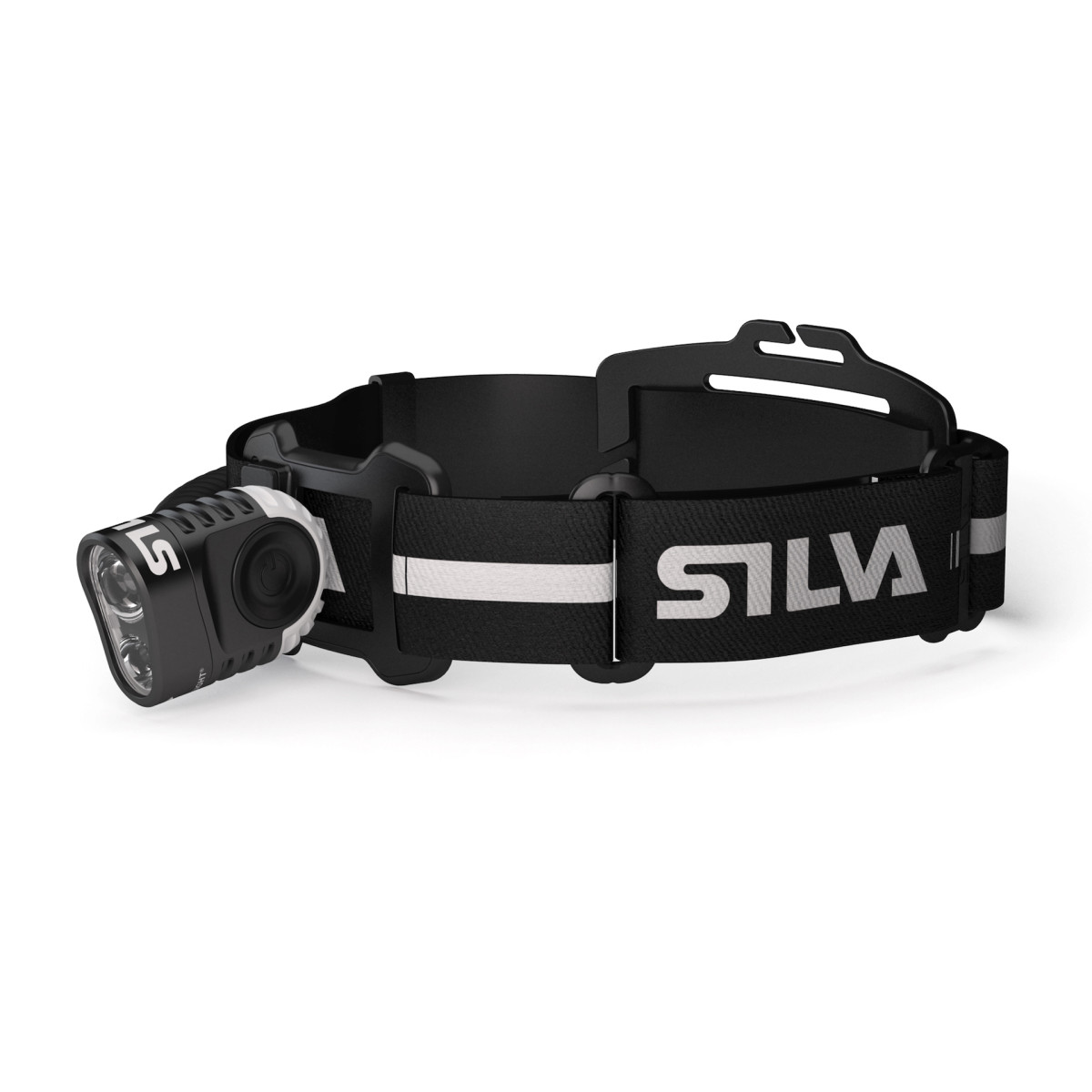
Silva Trail Speed 4XT 1200 Headlamp The Silva Trail Speed 4XT 1200 is a compact and water-resistant headlamp that comes with an adjustable spotlight and floodlight. Tilting it down makes the beam wider to cover more ground and tilting it up makes the beam narrower for long-distance focus. It has a detachable battery pack that can be worn on either the rear of the headlamp or stashed in a pack. The light and battery weigh a scant 245 grams. Light output is 1200 lumens and the rechargeable battery lasts up to 20 hours. $246; silva.se
Get it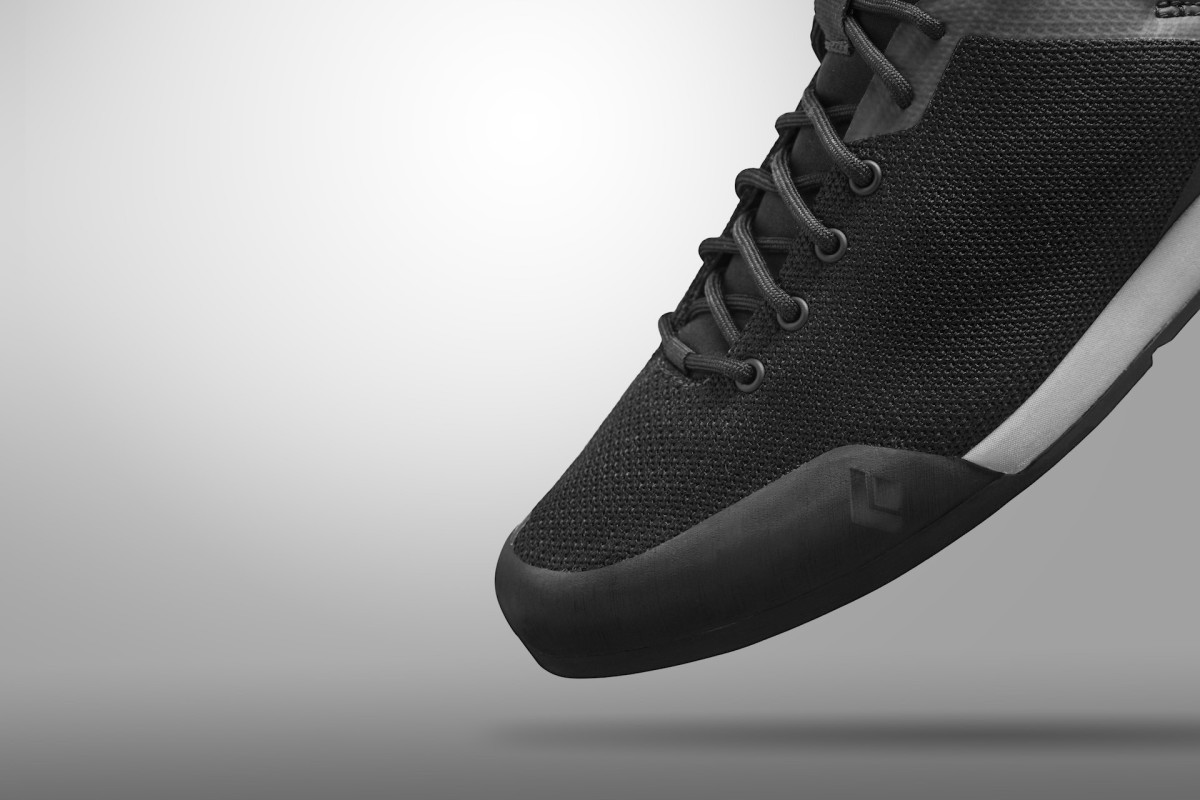
Black Diamond Circuit Approach Shoes Yosemite lies inside a 21,000-square-mile granite batholith, which means rocks are everywhere. Black Diamond’s Circuit approach shoes are made with breathable knit uppers so they stay cool on hot days, with sticky rubber soles for scrambling over slabs, technical hiking and light bouldering. $99; blackdiamondequipment.com
Get it
AirNET Climbing Harness This no-frills harness designed for competition climbing is what the world’s best climber, Adam Ondra, uses. It’s soft, supple, comfy to hang in at belays, and it folds into a small stuff sack so it takes up little room. Utilizing Black Diamond’s latest technologies, AirNET features low weight and high comfort, plus the new low-profile Infinity Belay Loop. The AirNET harness works equally well on everything from short sport climbs to the long cracks found on El Capitan. $160; blackdiamondequipment.com
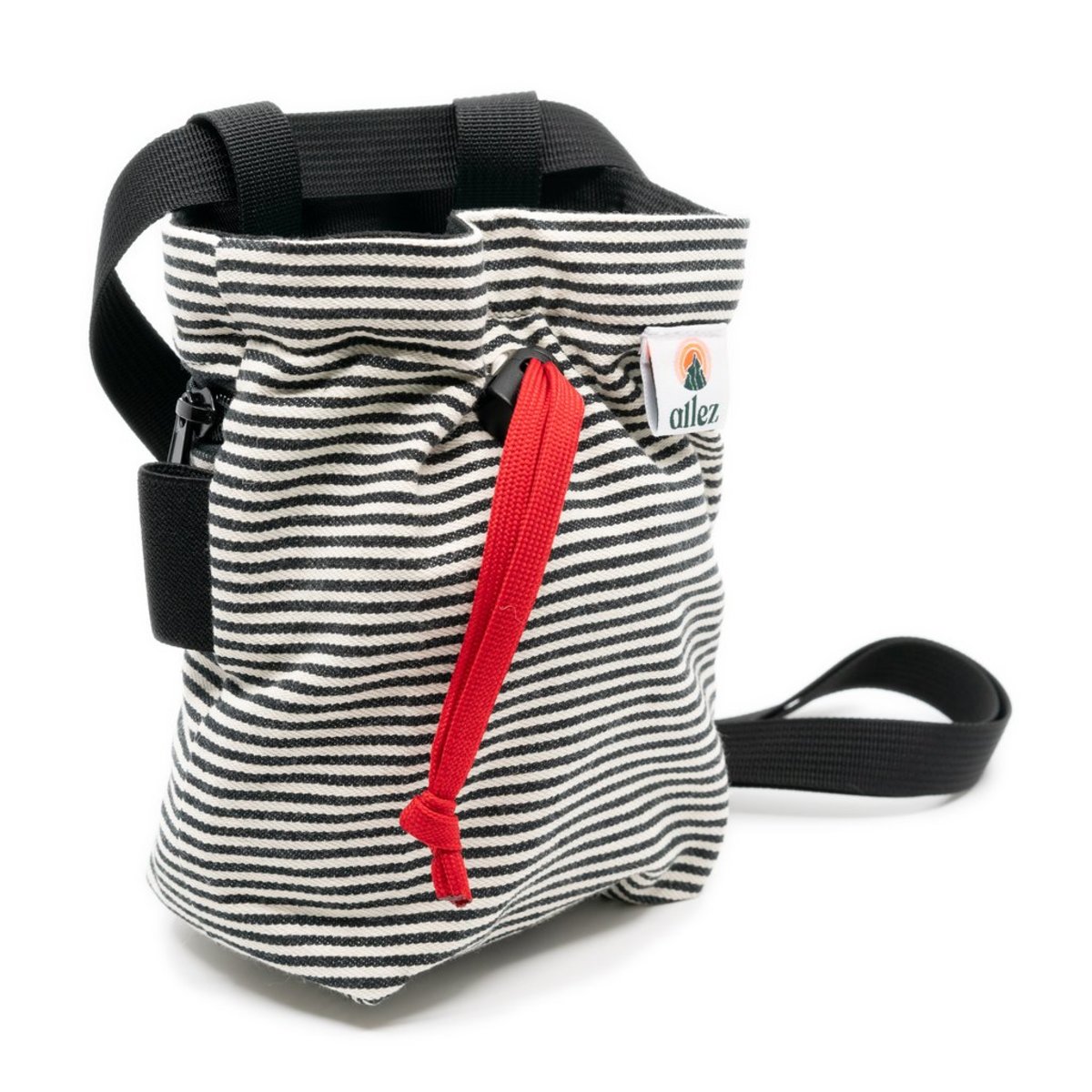
Allez Outdoor Limited Edition Upcycled Chalk Bag Generously sized so it can hold enough chalk to cover thousands of feet in a day without needing a refill, the Upcycled Chalk Bag is durable, fashionable, and comes with a large zippered pocket for keys or energy gels. Additional items from Allez include alpaca and merino wool beanies, biodegradable cleansing cloths and repair and recovery salves, with or without CBD. $30; allezoutdoor.com
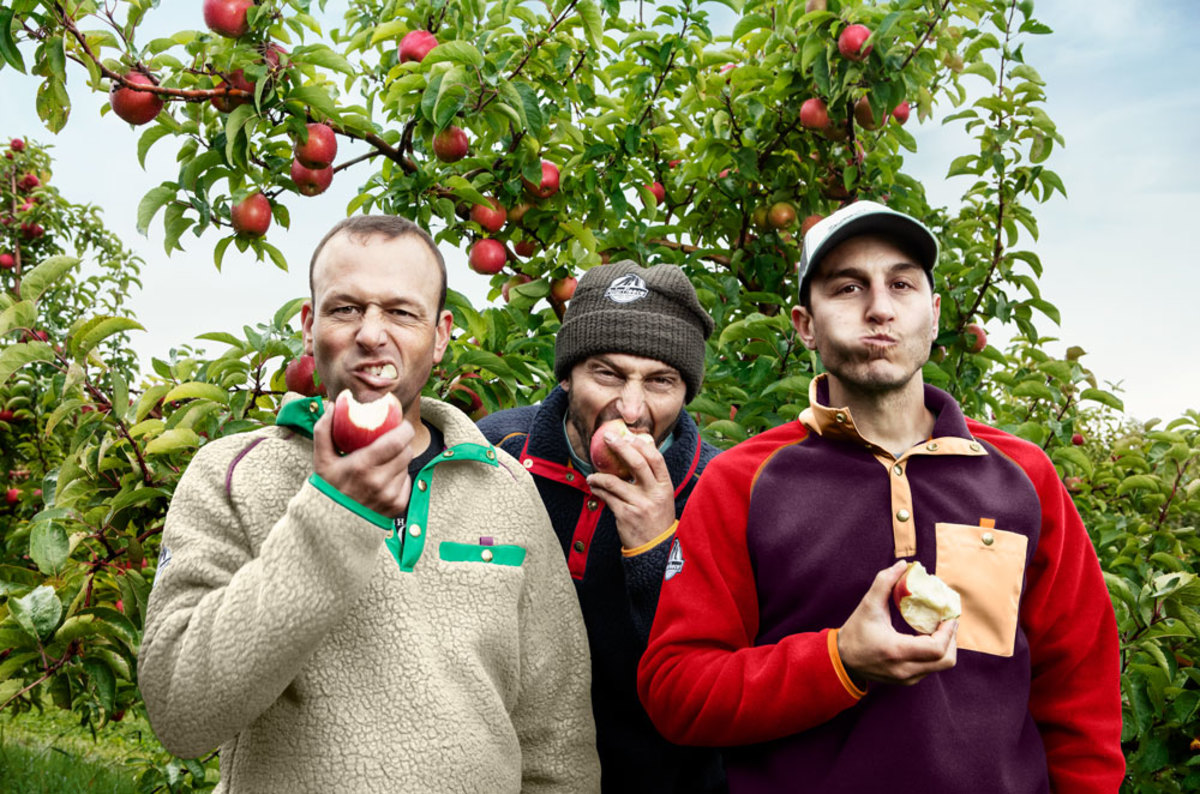
PolarFleece Customizable Pullover Through PolarFleece.com, Polartec is offering fully customizable pullover fleeces in either mid-layer weight Andover or heavy-weight Shearling. These pullovers are a nod to its original release in 1981, now offered in a variety of styles and colors that are designed entirely by you, down to the snap color and pocket ribbon. Made from 100 percent recycled bottles and sewn in New England, these layers are equally at home on chilly High Sierra mornings as they are halfway up a rock dome in Tuolumne Meadows. $140 Shearling, $120 Andover; polarfleece.com
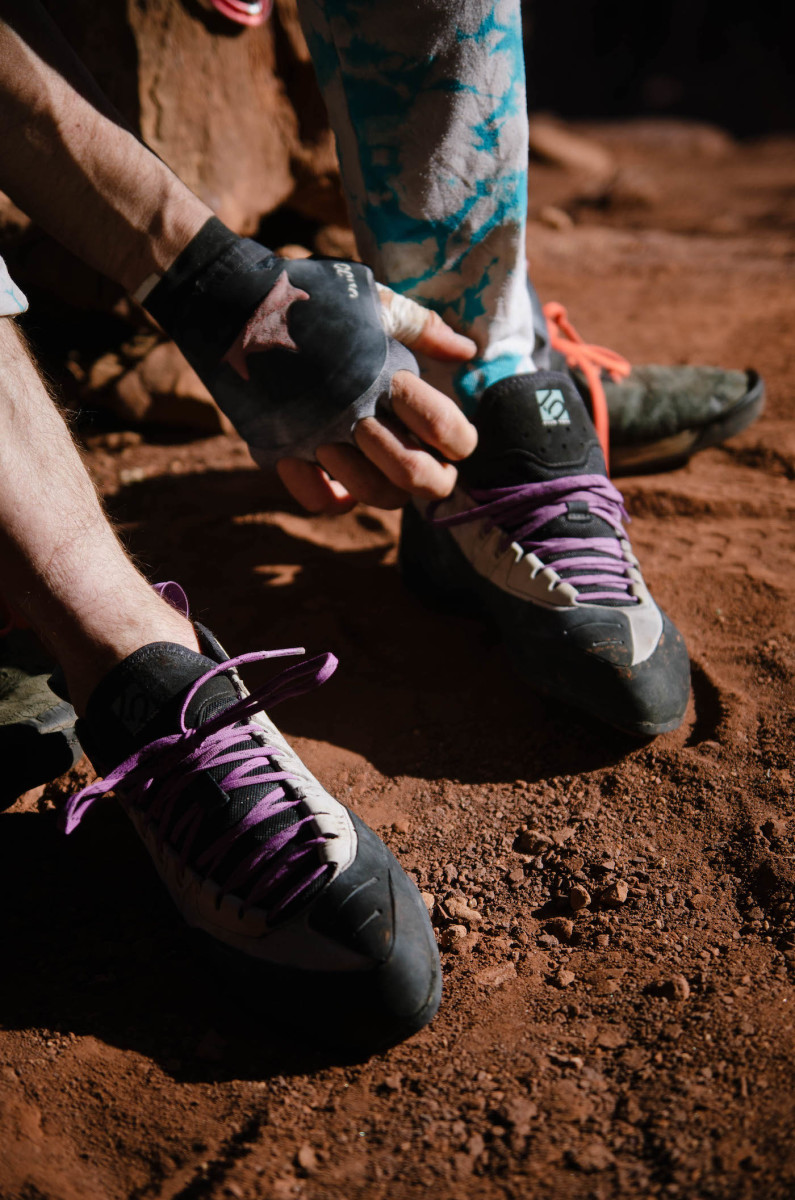
Five Ten Grandstone Climbing Shoes Founder of Five Ten Charles Cole (1955-2018) climbed the hardest big walls on El Cap and Half Dome in Yosemite. Inspired by climbing in the park, in 1985, Cole started his iconic shoe company and formulated the stickiest rubber in the world. With the shoes of his design laced onto his feet, Cole climbed demanding face and crack routes from Joshua Tree to Yosemite.
The all-round Grandstone has a protective, high-top design to protect ankles from sharp cracks, a stiff sole for all-day support, and low-stretch fit. They ship with Stealth C4 rubber, the grippy compound that put Five Ten on the map. on sale for $108; adidasoutdoor.com
Once assumed to be safe from the dangers of COVID-19, younger adults share their prolonged struggles with the disease.
from Yahoo News - Latest News & Headlines https://ift.tt/2ZlkI1V
via IFTTT

New research found that only 13% of dog owners and about one-third of cat owners exclusively fed their pets conventional pet foods as their main meals all of the time.

More doctors have become aware of cognitive behavioral therapy for insomnia (CBTI), a nondrug treatment that can improve sleep by helping patients change beliefs and behaviors.
Fourth of July festivities will certainly look different this year. But even in a socially distant world, some things will remain the same: Folks will fire up grills, unwind by the water, and crack a couple cold beers. Here are seven of our favorite beers for celebrating Fourth of July.
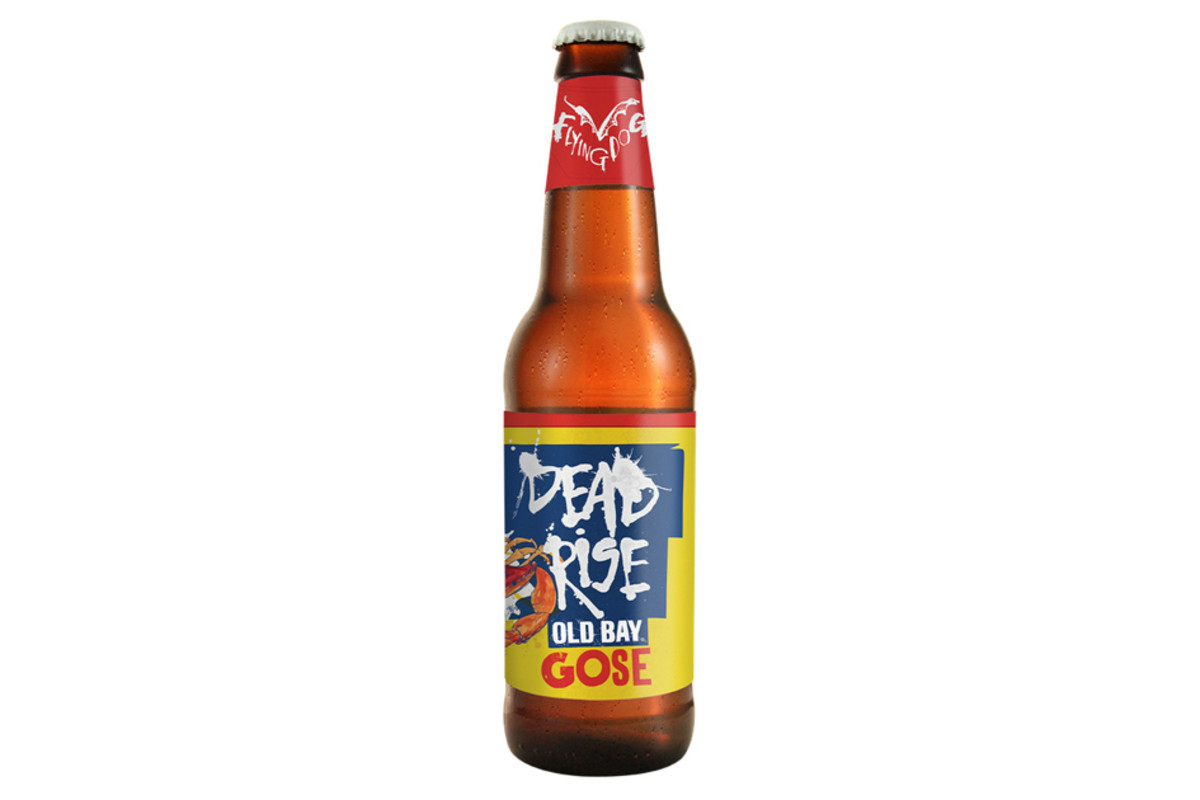
Summer in Maryland means shellfish, namely steamed blue crabs showered with Old Bay seasoning and served with cold beer. Might we suggest Flying Dog’s newly reformulated Dead Rise, a tartly quenching gose flavored with Old Bay for a salty, spicy kick. It tastes like summer alongside the Atlantic Ocean.
[woodbridge.jcanals.com; drizly.com]
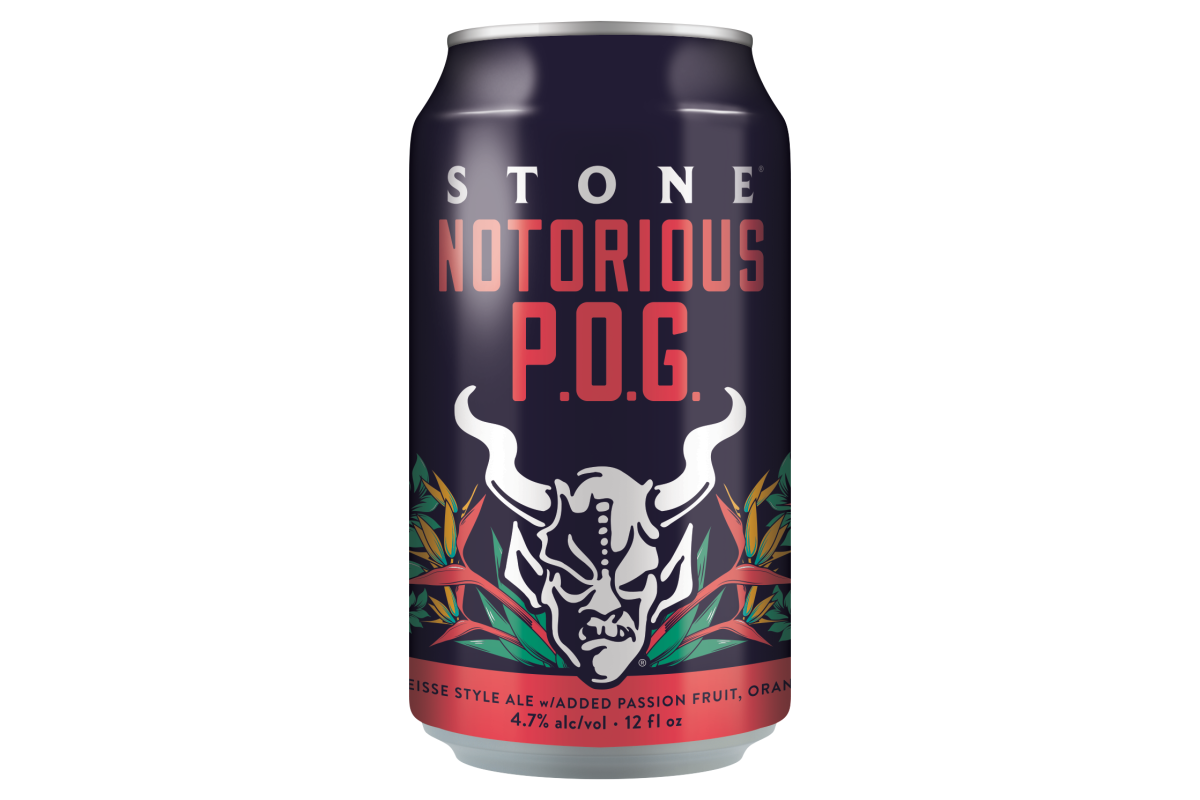
One of Hawaii’s most beloved beverages is POG, a blend of passion fruit and orange and guava juices. Stone channels the popular beverage’s tropical verve in Notorious P.O.G., a hugely refreshing fruited Berliner weisse with a slash of bright acidity. P.O.G. rules for day drinking and alongside cold, ripe watermelon.
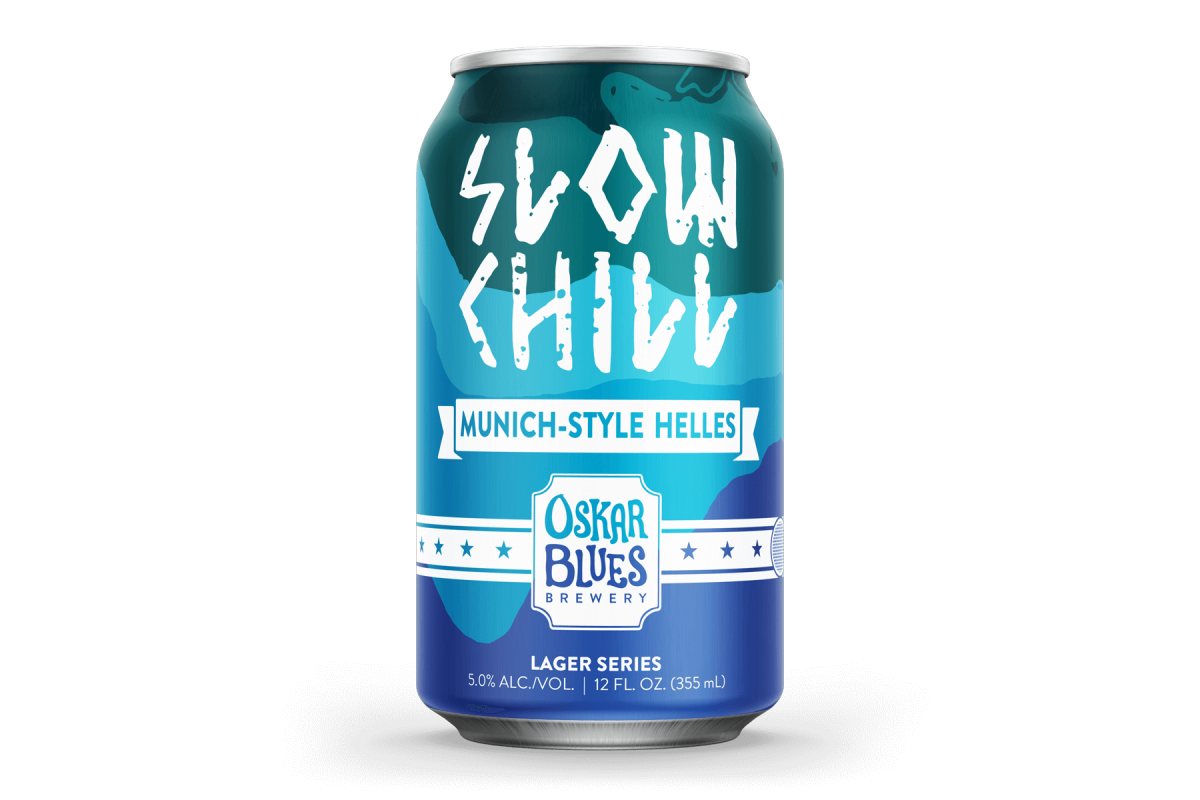
Outdoor-loving Oskar Blues is known for its boldly flavored pale ales, stouts, and IPAs, but the Colorado brewery is also quietly crushing the lager game with its Slow Chill series. The latest release is Helles (German for light or bright), a golden glugger that goes well with burgers, sausages, and other grilled goodies.

Loaded with lively lime and rimmed with salt, the margarita is a perfect summer beverage save for one fatal flaw—it’s tough to drink cocktails all day long. The solution to this very particular party conundrum is Cigar City’s low-alcohol Margarita Gose that’s also flavored with a bit of orange peel. Fun fact: Instead of using Lactobacillus bacteria to add acidity, Cigar City now opts for a unique yeast strain.
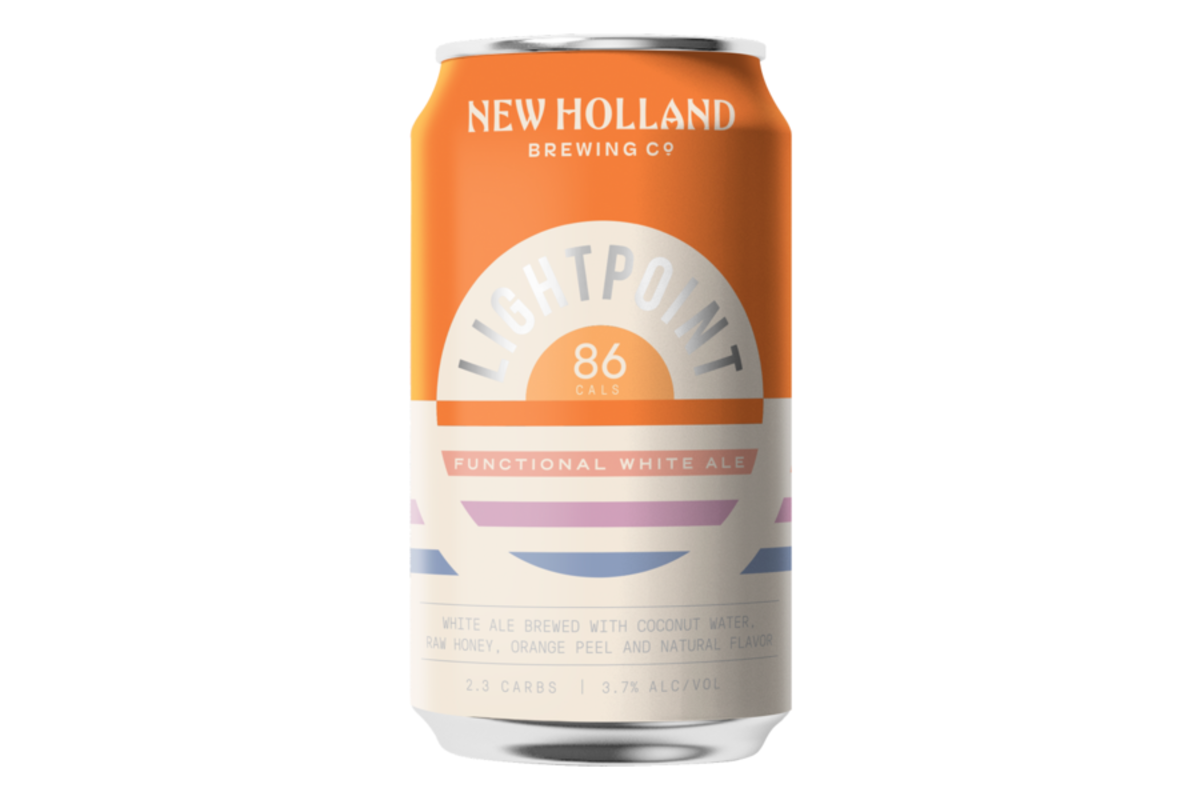
If your Fourth of July festivities also include a long run, bike ride, or other sweaty activity, look to fill your coolers with New Holland’s 86-calorie white ale with just two grams of carbs. It’s brewed with raw honey, orange peel, and coconut water, creating a flavorful pick-me-up that puts the “fun” in functional beverage.
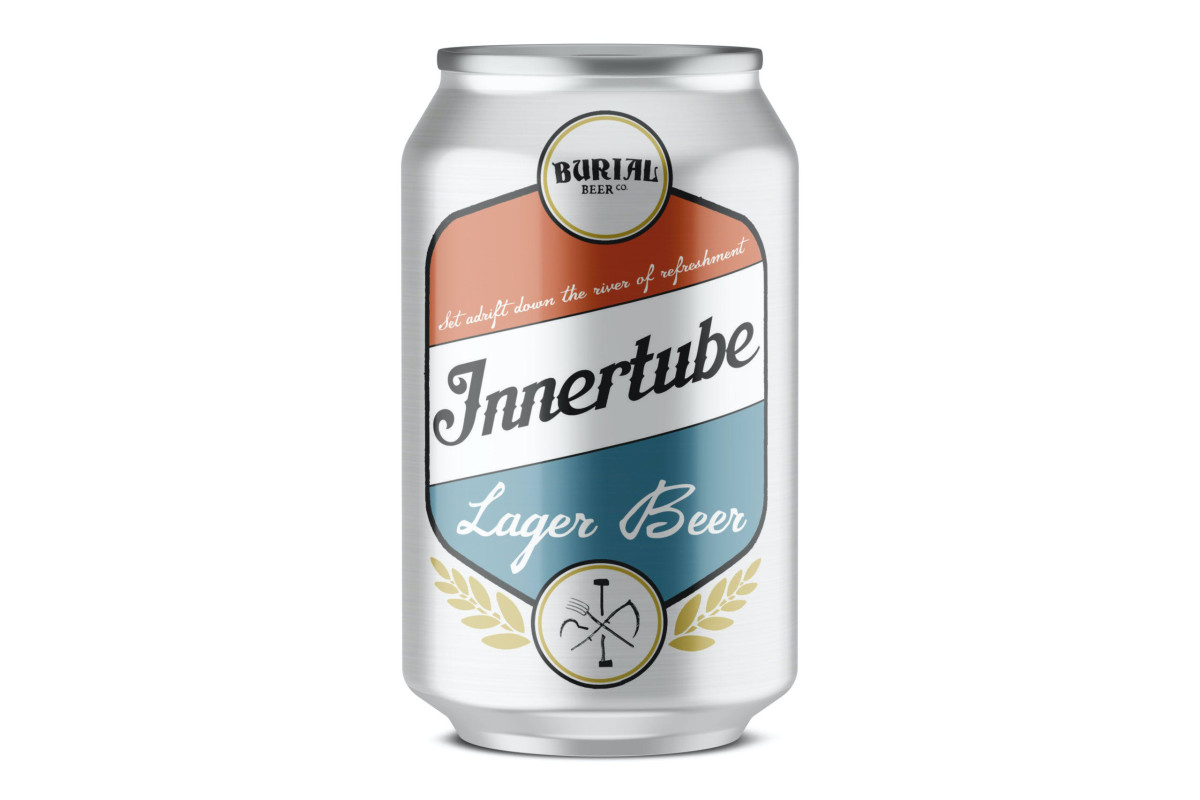
Over the last few years, craft breweries have started putting their spin on the fizzy light lager, giving the mass-market mainstay a flavorful facelift. One of our favorite new-breed light lagers is Burial’s Innertube, fashioned with corn, rice, and German hops to create the ultimate koozie beer. P.S. You can buy the beer directly from the brewery, too.
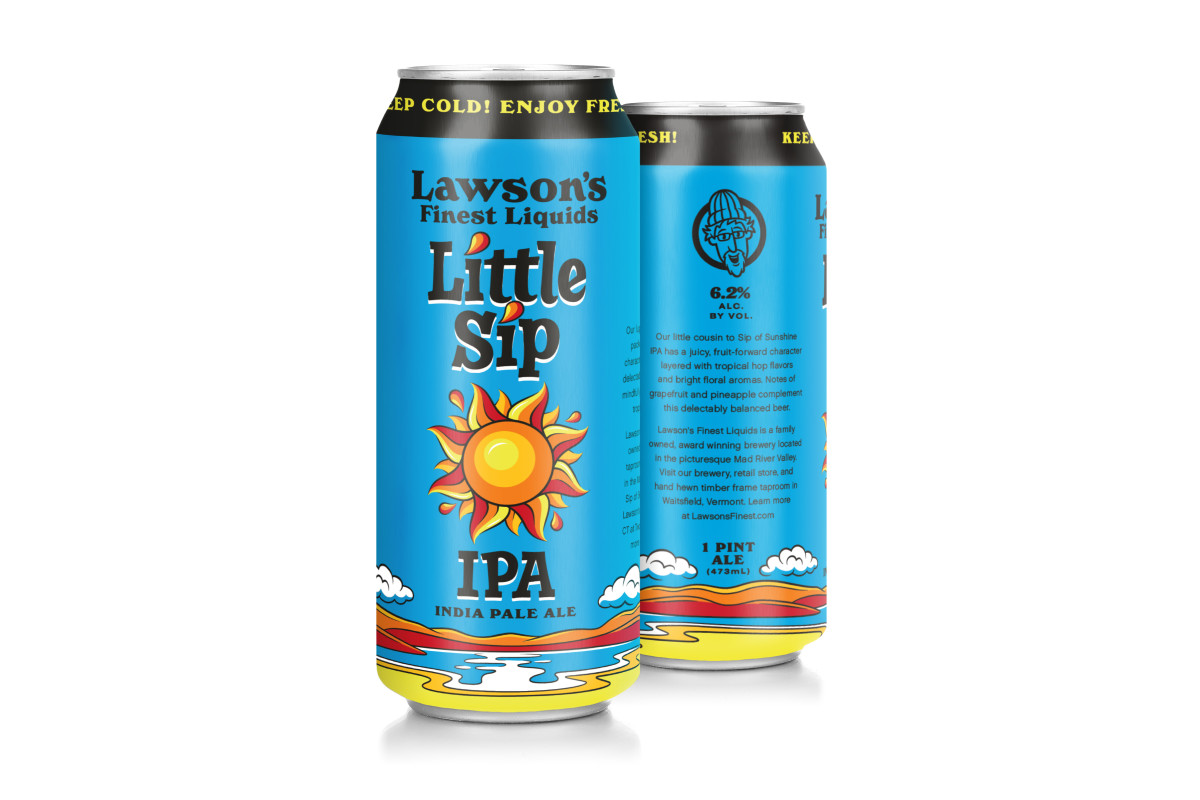
This summer, the Vermont IPA specialists unveiled this sibling to its flagship double IPA, Sip of Sunshine. Little Sip offers similar super-charged scents of just-squeezed grapefruit and sun-ripened pineapple, but the lower alcohol makes this IPA great for sipping beneath the—you guessed it—bright July sunshine.
Travel restrictions remain in place in many states. But that doesn’t mean you can’t get away. This summer, close-to-home adventures, like camping out in your own state, could be the new European vacation.
Lunolife’s 2.0 inflatable double mattress is perfectly sized to fit in the back of your car, so you don’t need to worry about setting up a tent or towing a trailer. It redefines car camping by turning your car into a poor man’s camper van while setting you up for a good night’s sleep whether you’re loaded for a spontaneous overnight or a summer road trip.
Pete Ducato (dirtbag/product designer/LunoLife founder) came up with the idea on his regular snowboard trips to Mammoth Mountain. Unwilling to pay for a hotel, he’d sleep in his car with a camping pad, and think about how the car camping experience could be improved.
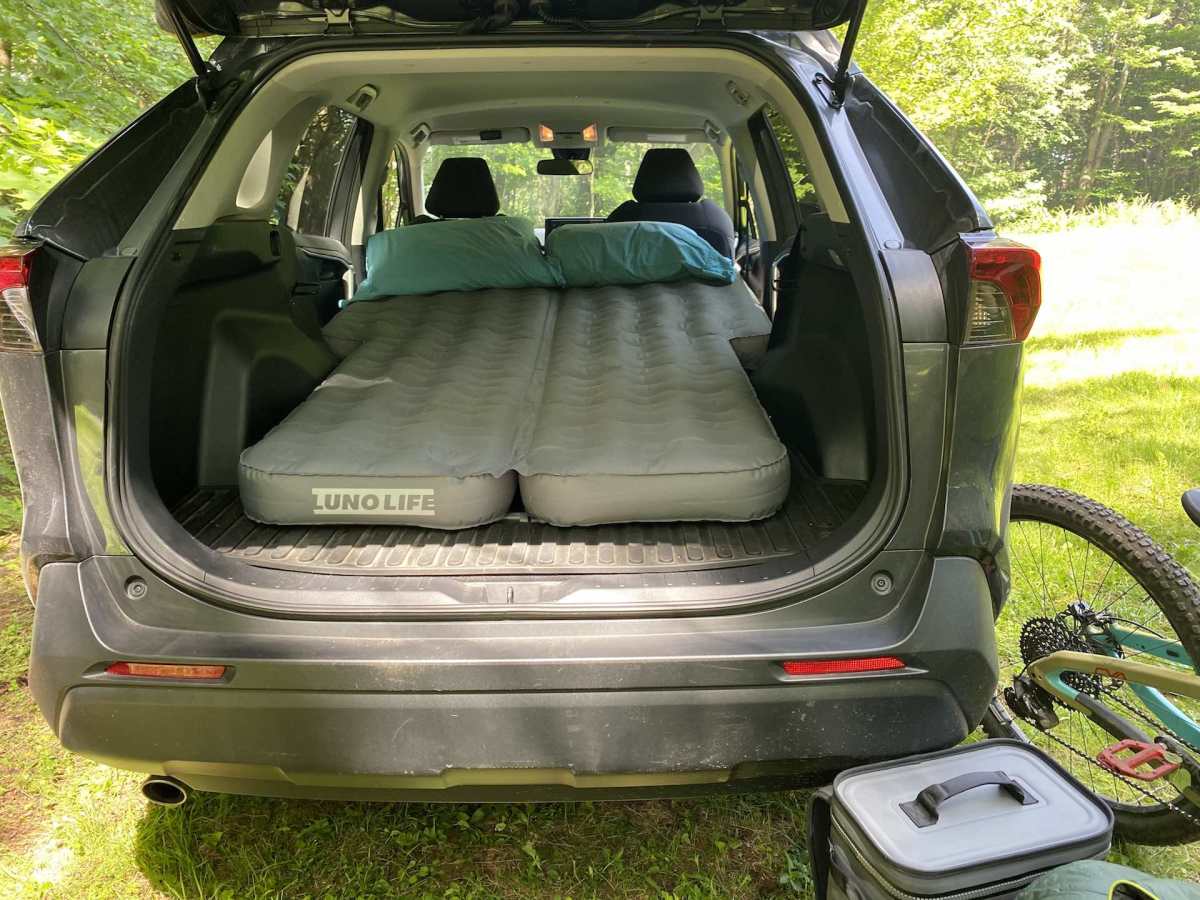
His answer was the 15-pound, 4-inch-thick, two-person mattress that looks like two luxury camping mats permanently mated. Each side has its own inflation and deflation port. When you’re ready to snooze, slide your driver and passenger seats forward, unfold the rugged, nylon mattress in your trunk, hook up the included 12-volt electric air pump to your car’s outlet and the mattress. In five short minutes, your trunk turns into your bed.
Printed rectangles on the mattress top indicate where your pillows should go, though there’s no reason you can’t flip and sleep with your head near the hatchback instead of the front seats.
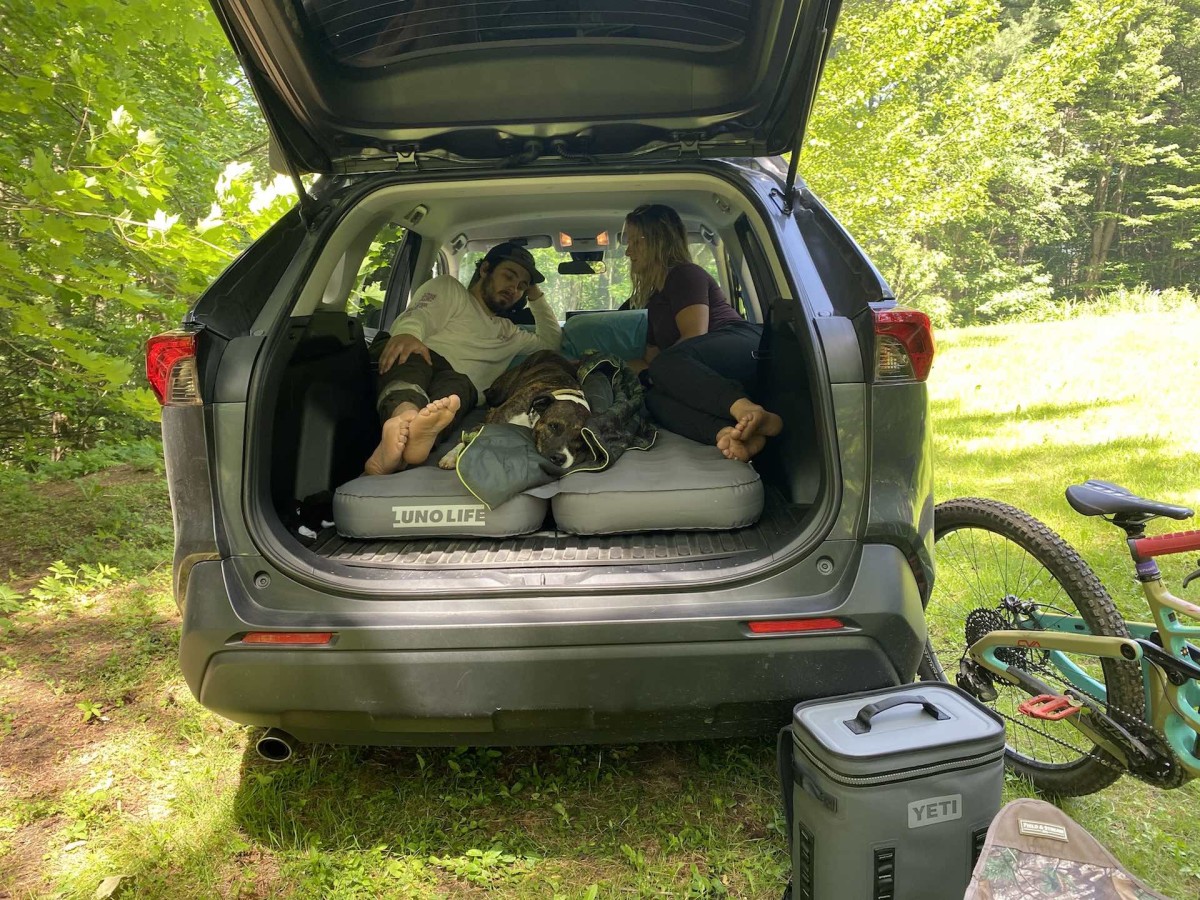
Sleeping in the back of a car has only ever been awkward—multiply that by two if you’re sleeping with a friend. Cram two mattresses into your trunk and they’re certainly going to overlap (or leave a gap).
This mattress practically guarantees a good night’s sleep. It encourages snuggling and ensures no one will fall through the gap, whether your bedmate is human or a canine. And if each occupant prefers a different mattress firmness, that’s easy to control, because the sides are mated but the inflation for each side is independent. It also means when your mattress mate flips and flops during the night, you won’t experience the turbulence you would sharing another inflated double bed.
In addition to the mattress and pump, LunoLife comes with two inflatable cubes that stuff behind the driver’s and passenger’s seats to support the head of the mattress when your wheel wells are empty. It was a good call to make them auxiliary. I typically use the wheel wells to store cooking gear, clothing, and more. Partially inflated cubes did a great job of taking up empty space.
LunoLife version 1.0 felt like an inflatable airbed you’d buy at Walmart. Version 2.0 is much more rugged, tough enough to resist dog toenails, and the scraping and scratches of many seasons of use. It also dissipates body heat better so it didn’t feel clammy. The inflation and deflation valves are now easy to get to, with reflective chord on the plugs that made them easy to pull out.
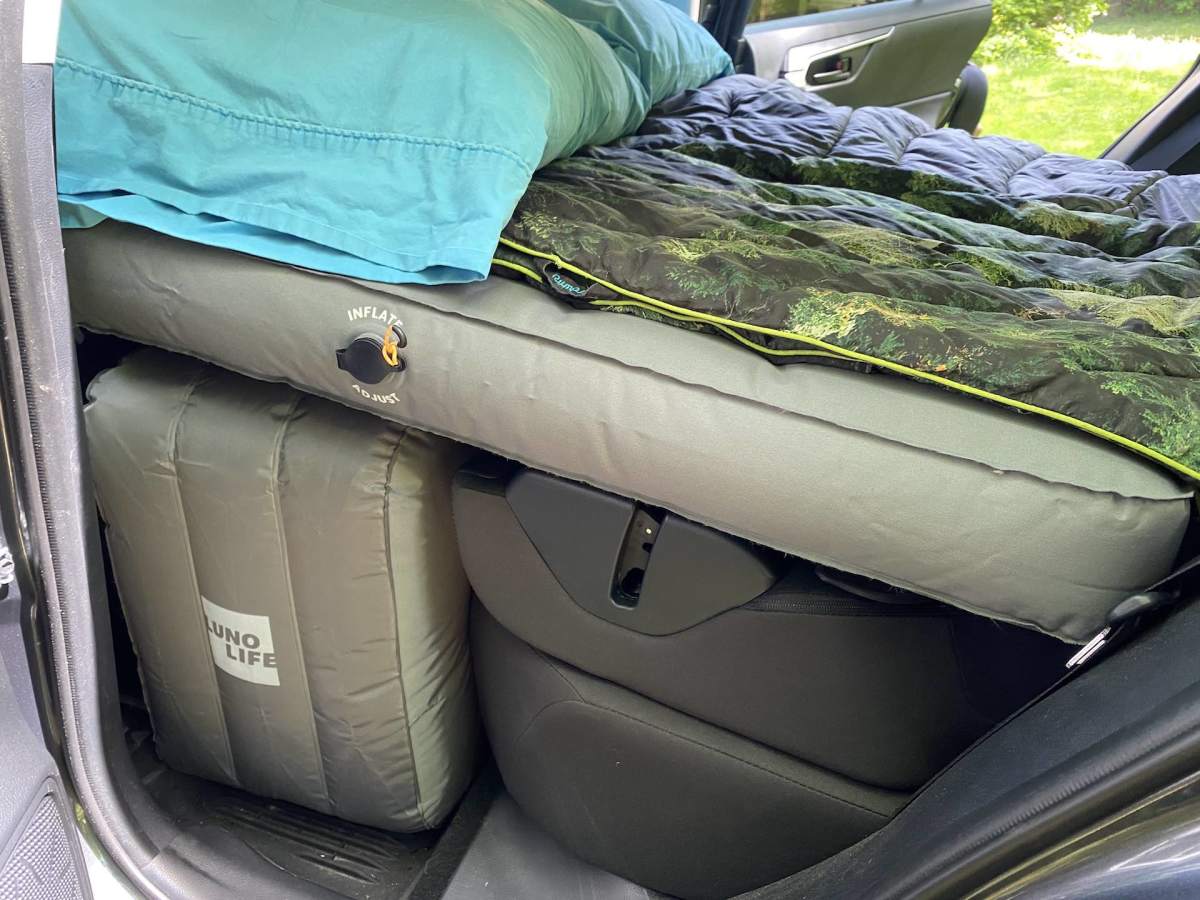
Because this 4-inch-thick mattress is designed to be used inside a car, it’s not insulated. Four inches of air provides an R-value of 1, which is perfect for spring and summer nights. If you’re using the mattress in winter, bring extra bedding for under and over you as an extra buffer against the cold.
When you’re not using the LunoLife, store it in its denim-looking cinch-top bag, which is big enough to hold the mattress, behind-the-seat cubes, and the pump. A pocket in the pack contains a patch kit.
Later this summer, LunoLife will release its XRD overlanding mattress. The XRD will have a center zip to separate the sides when you’re traveling solo and packing a lot of gear, and it will be even tougher.
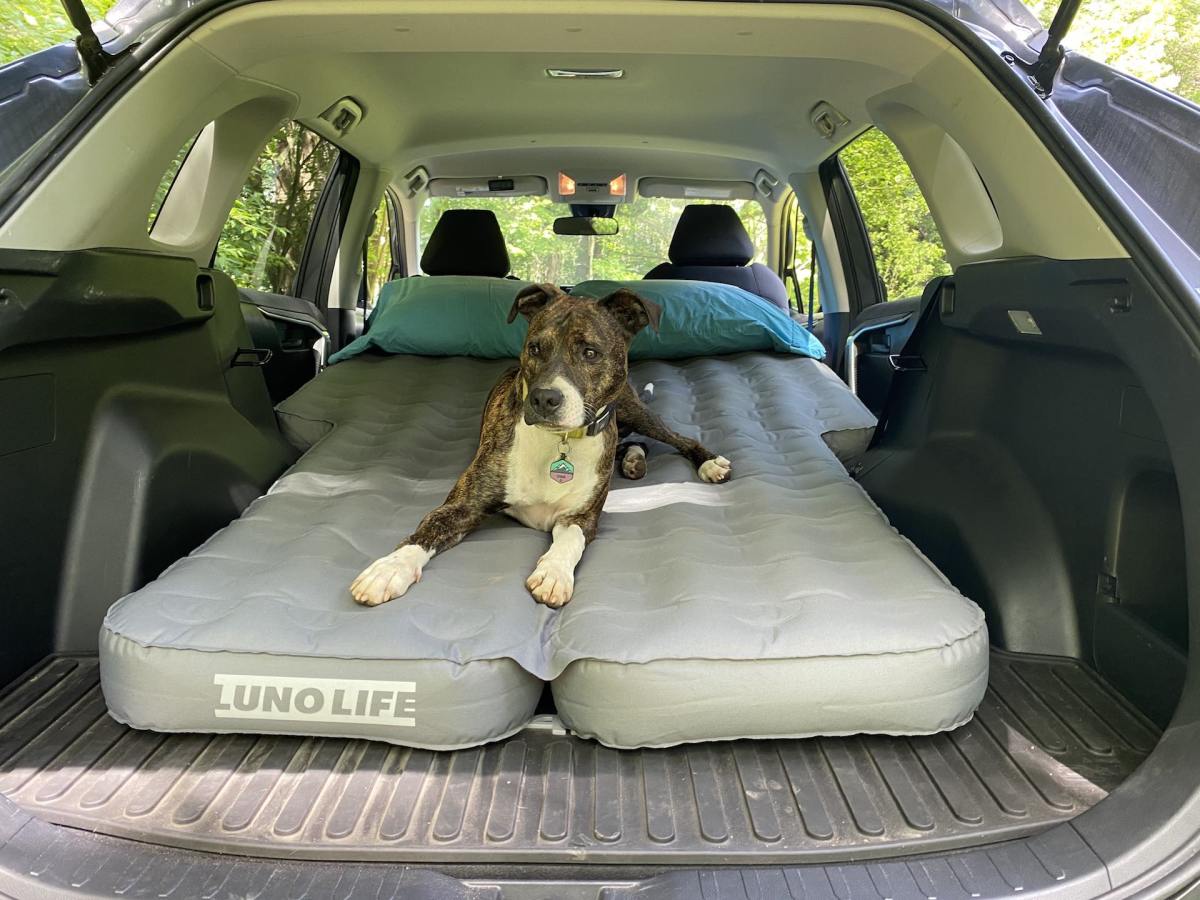
The 12-volt electric pump supplied with each mattress sounds like a hairdryer on steroids, and the noise felt incompatible with the serenity of the woods, the mountains, and nature in general. I’d love a quieter inflation option, whether it’s manual, like a stuff sack that mates to the mattress valves, or a quieter pump.
Also, we hope LunoLife’s next product is a universal screen for car windows and back hatches. Because the only thing bad about camping in your car is having to choose between sweating with the windows closed or getting chomped by mosquitoes.
[$225, lunolife.com]
Get itEveryone talks about the importance of treating high blood pressure, the “silent killer.” And everybody knows that untreated high blood pressure can lead to heart attacks and strokes. But can treating high blood pressure reduce your risk of cognitive impairment and dementia?
Cognition encompasses thinking, memory, language, attention, and other mental abilities. Researchers have known for many years that if you have high blood pressure, you have a higher risk of developing cognitive impairment and dementia. However, just because high blood pressure is a risk factor, it does not necessarily mean that lowering high blood pressure will lower your risk. Many things in health and science correlate without one causing the other (my favorite is the correlation between the drop in birth rate and the decline in the stork population). Thus, randomized, double-blind, controlled studies are needed to answer this question.
There have, in fact, been a lot of these studies. The most recent relevant study is the SPRINT-MIND study, designed to measure the effects of lowering high blood pressure on dementia and/or mild cognitive impairment. This study was so successful at reducing the risk of mild cognitive impairment by lowering high blood pressure that it ended early, because the data and safety monitoring board felt that it was unethical to continue the control group. However, the dementia endpoint had not yet reached statistical significance — likely because of this early termination. Thus, while the study succeeded in one sense, it ultimately concluded that treating systolic blood pressure to below 120 mmHg (versus lower than 140 mmHg) did not reduce risk of dementia.
Because SPRINT-MIND and many other prior studies have not clearly shown whether lowering our high blood pressure can reduce our risk of cognitive impairment and dementia, meta-analyses are needed to answer this question. Researchers in Ireland looked at data from 14 studies comprising almost 100,000 participants, followed over an average of more than four years. They found that older individuals (average age 69) who lowered their blood pressure are slightly less likely to develop dementia or cognitive impairment (7.0% versus 7.5%). Thus, the answer is: Yes! Lowering high blood pressure will lower our risk of dementia and cognitive impairment.
So, how does lowering high blood pressure reduce our risk of cognitive impairment and dementia? Most people who have dementia don’t have just a single cause. Two or even three different problems in the brain cause their cognitive impairment and lead to their decline in function. One study estimates that the fraction of dementia risk attributable to cerebrovascular disease — that is, strokes — was nearly 25% in people who developed significant memory loss late in life. These researchers also found that the dementia risk attributable to Alzheimer’s disease was considerably higher, nearly 40%.
My reading of the literature is that lowering blood pressure reduces dementia risk because it reduces the risk of stroke. It’s the strokes — not high blood pressure by itself — that cause cognitive impairment. Note, however, that the strokes may be so tiny that one doesn’t even know that they have them. But developing a lot of these tiny strokes (or a few big ones) will greatly increase our risk of dementia.
Okay, but what’s considered a healthy blood pressure from the perspective of the brain? The SPRINT-MIND study answers that question: people are less likely to develop mild cognitive impairment if their systolic blood pressure is lower than 120 mm Hg compared to the control condition of between 120 and 140 mm Hg. Thus, for optimal brain health, it’s best to keep your systolic blood pressure below 120 mm Hg — at least according to the SPRINT-MIND study.
The take-home message is clear: You can reduce your risk of cognitive impairment and dementia by lowering your systolic blood pressure to less than 120 mm Hg, preferably with aerobic exercise, a Mediterranean diet, and a healthy weight, and by adding medications if those lifestyle changes alone are not sufficient.
The post Can controlling blood pressure later in life reduce risk of dementia? appeared first on Harvard Health Blog.
Vice President Mike Pence peeled off his White House-branded mask and smiled at a crowd of thousands Sunday morning. Yet he wasn’t technically headlining a political rally — he was at church in a state that has seen a dramatic spike in coronavirus cases.
from Yahoo News - Latest News & Headlines https://ift.tt/2ND6nIS
via IFTTT
Hundreds of elite paddlers from around the world will not be flying into Honolulu the last week of July. They won’t be cruising in flip-flops over to Molokai, and won’t be embarking on the most grueling mental and physical challenge of their lives. They won’t be emotionally gliding into Maunalua Bay Beach Park and celebrating at the Outrigger Canoe Club with a community of endurance brothers and sisters.
It would be easy to just write this year’s Molokai 2 Oahu Paddleboard World Championship off as another coronavirus-related bummer, along with the scratched NBA season and Pearl Jam tour. However, the M2O race is still happening, albeit virtually, from around the world.
Anyone can do it on any craft. Anything goes.
This year, instead of making the trek to Hawaii, paddlers will set up their own routes and paddle their local waters anytime between July 24-26 on whatever craft they so choose to paddle, half the distance of the storied 32-mile, island-to-island course. This means you. To bring the whole thing together, registered paddlers can upload race files, including locations and conditions, or simply share their paddle on social media.
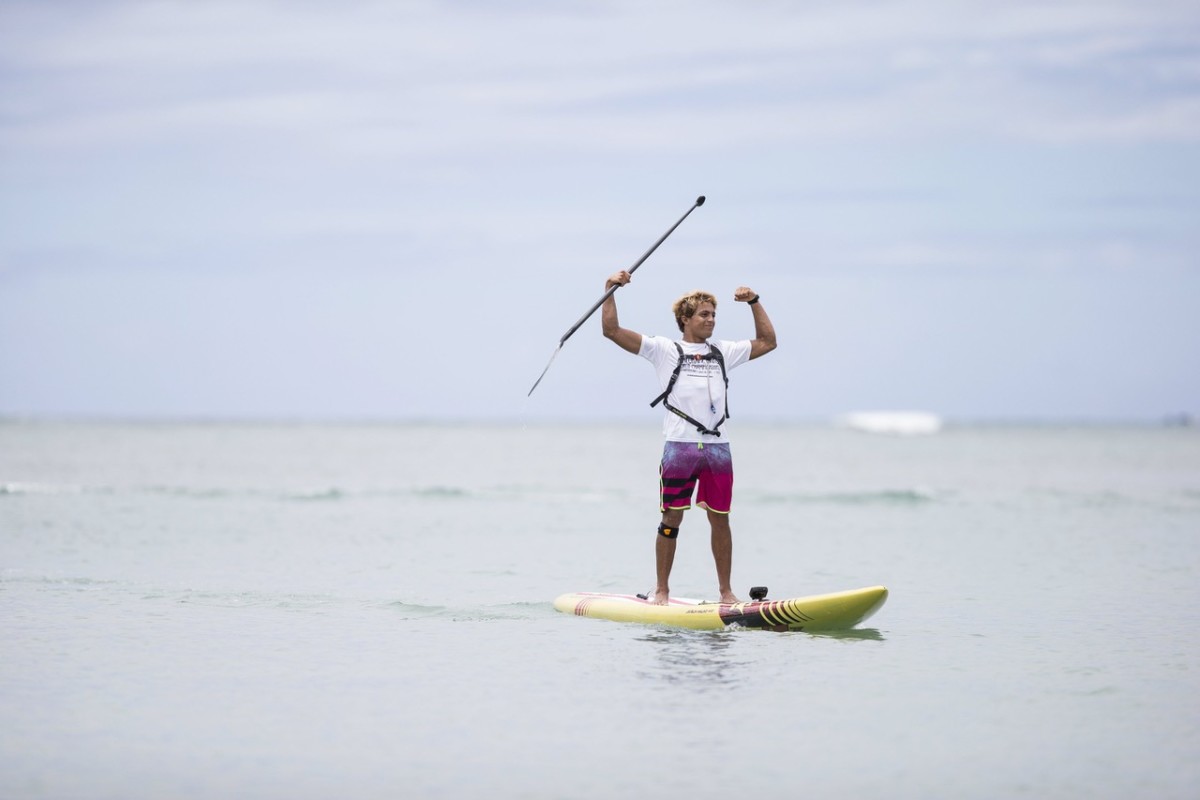
“I’m most excited to see where people might be paddling,” says Kai Lenny, the figurative and literal poster boy for the event. “They’ll be on rivers, lakes, harbors. There’s going to be someone paddling a pond by their house, going around it 400 times. There will be some unbelievable feats to come out of this.”
Lenny, the Maui native surf-kite-sail-big-wave-paddle-foil wonder, can do pretty much anything on any combination of board and water. Lenny set a new record tie for the 2018 event, racing on a foil-SUP. Before that, he was champ of both the Stand Up Paddle Unlimited and Stock divisions.
The Molokai 2 Oahu race, considered the most elite paddle race in the world, is 32 miles across the Molokai Channel, also known as the Ka’iwi Channel. Racers have to qualify, then put up their own money for flights, accommodations and a chartered support boat.
What Lenny says he will miss the most is the spirit of inclusiveness among paddlers.
“There are no ‘outsiders’ at this event,” Lenny says. “If you’re new to the event, everyone who has already done it celebrates your first time. At the opening ceremony, they announce the newest paddlers and everyone claps and cheers. Everyone specifically wishes you good luck. You’ve earned the right to be there and you’re about to embark on one of the greatest challenges you’ll ever have.”
It’s also not the paddling world’s only legendary challenge to go virtual. The Yukon River Quest, the world’s longest running paddle race that takes paddlers 444 miles on the Yukon River, will also be virtual and also half the distance.
Half the distance for this year’s M2O racers means 16 miles on any body of water chosen. Though competitors will be decentralized physically, Lenny mentioned being pleased with event directors putting in the effort to keep the community connected digitally. And he sees new opportunities. For one, any racer can to compete next to Lenny or the lead paddlers. And athletes from around the world will be checking out each other’s local backwaters and personal best times.
“Maybe there are people who have never been able to travel to do this race,” Lenny adds. “They have jobs, families and other priorities at home. How cool that they now have an opportunity? Anyone who wants to put in the time and energy can be part of it. Maybe this is a stepping stone for them to get to Hawaii and do it next year. Maybe they’re going to push themselves that much harder. It helps you feel the camaraderie with this community.”
He also understands his role in that community, and the pressure to compete. Though he may be uploading his paddle like everyone else, he won’t be “phoning it in.” Lenny’s coming out of quarantine in fighting shape, looking for the best day of wind and weather that weekend to actually stroke the channel.
If you’re interested in signing up, register at molokai2oahu.com ($80 gets you an event hat, T-shirt, M2O camp mug, custom neck gaiter, and sarong). Then all you have to do is paddle 16 miles and you’ve competed in the famed paddle crossing, sort of.